Wood Duck Aix sponsa
Order: Anseriformes. Family: Anatidae
Description
The wood duck is a medium-sized perching duck. A typical adult is from 47 to 54 cm (19 to 21 in) in length with a wingspan of between 66 to 73 cm (26 to 29 in). This is about three-quarters of the length of an adult mallard. It shares its genus with the Asian Mandarin duck (Aix galericulata). The adult male has distinctive multicolored iridescent plumage and red eyes,with a distinctive white flare down the neck. The female, less colorful, has a white eye-ring and a whitish throat. Both adults have crested heads.
Distribution
The birds are year-round residents in parts of its southern range, but the northern populations migrate south for the winter. They overwinter in the southern United States near the Atlantic coast. 75% of the wood ducks in the Pacific Flyway are non-migratory. They are also popular, due to their attractive plumage, in waterfowl collections and as such are frequently recorded in Great Britain as escapes—populations have become temporarily established in Surrey in the past but are not considered to be self-sustaining in the fashion of the closely related Mandarin duck. Given its native distribution the species is also a potential natural vagrant to Western Europe and there have been records in areas such as Cornwall, Scotland and the Isles of Scilly which some observers consider may relate to wild birds; however, given the wood duck's popularity in captivity it would be extremely difficult to prove their provenance one way or another. There is a small feral population in Dublin. They are an introduced species in South Africa.
Habitat
They are found in wooded swamps, marshes, streams, beaver ponds, and small lakes. They stick to wet areas with trees or extensive cattails.
Diet
Wood Ducks eat seeds, fruits, insects and other arthropods. When aquatic foods are unavailable they may take to dry land to eat acorns and other nuts from forests and grain from fields. Diet studies indicate a lot of variability, but plant materials make up 80% or more of what the species eats.
Breeding
The Wood Duck nests in trees near water, sometimes directly over water, but other times over a mile away. After hatching, the ducklings jump down from the nest tree and make their way to water. The mother calls them to her, but does not help them in any way. The ducklings may jump from heights of over 50 feet without injury.
Wood Ducks pair up in January, and most birds arriving at the breeding grounds in the spring are already paired. The Wood Duck is the only North American duck that regularly produces two broods in one year.
Call
The male's call is a rising whistle, jeeeeee; the females utter a drawn-out, rising squeal, do weep do weep, when flushed, and a sharp cr-r-ek, cr-e-ek for an alarm call.
Status
IUCN Conservation Status: Least Concern
Africa Wild Bird Book
- Flutterby
- Posts: 44150
- Joined: Sat May 19, 2012 12:28 pm
- Country: South Africa
- Location: Gauteng, South Africa
- Contact:
Wood Duck (Introduced) Photos
Wood Duck Aix sponsa
Order: Anseriformes. Family: Anatidae
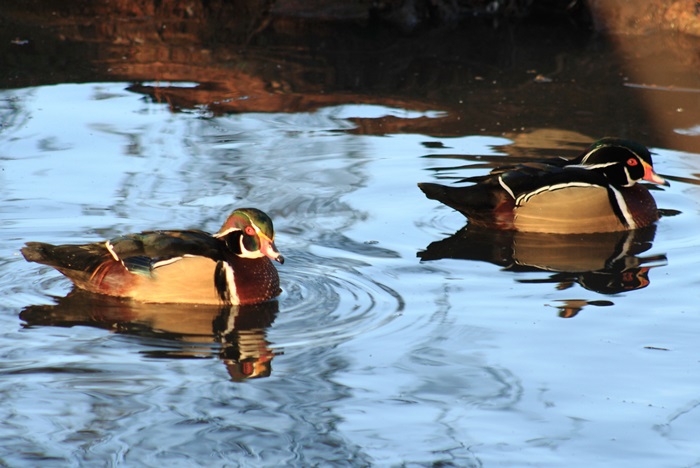 © Flutterby
© Flutterby
Tree Haven, Gauteng
Order: Anseriformes. Family: Anatidae
 © Flutterby
© FlutterbyTree Haven, Gauteng
ORDER GALLIFORMES
ORDER GALLIFORMES
Galliformes is a large and diverse group comprising about 70 genera and more than 250 species. Taxa within Galliformes are commonly referred to as 'gallinaceous birds' (meaning chicken-like) or game birds (as many species are hunted). Gallinaceous birds are chicken-like in appearance, with small to large bodies and blunt-wings. Plumage coloration ranges from cryptic to dark to brightly colorful. Some gallinaceous birds have elaborate head and neck ornamentation including wattles and casques. Some are primarily arboreal and others are terrestrial. Social groups may range from solitary dwellers to mated pairs to gregarious flocks. Mating systems range from monogamy to polygyny to polygynandry.
They are chicken-like in appearance, with rounded bodies and blunt wings, and range in size from small at 15 cm to large at 120 cm. They are mainly terrestrial birds and their wings are short and rounded for short-distance flight.
Gallinaceous birds are arboreal or terrestrial animals; many prefer not to fly, but instead walk and run for locomotion. They live from 5–8 years in the wild and up to 30 years in captivity. They can be found worldwide and in a variety of habitats, including forests, deserts, and grassland. They use visual displays and vocalizations for communication, courtship, fighting, territoriality, and brooding.
They have diverse mating strategies: some are monogamous, while others are polygamous or polygynandrous. Male courtship behavior includes elaborate visual displays of plumage. They breed seasonally in accordance with the climate and lay anywhere from 3-16 eggs per year in nests built on the ground or in trees.
Gallinaceous birds feed on a variety of plant and animal material, which may include fruits, seeds, leaves, shoots, flowers, tubers, roots, insects, snails, worms, lizards, snakes, small rodents, and eggs.
Adult males of many galliform birds have one to several sharp horny spurs on the back of each leg, which they use for fighting. In several lineages, there is pronounced sexual dimorphism, and among each galliform clade, the more apomorphic ("advanced") lineages tend to be more sexually dimorphic.
This order contains only two families found in Southern Africa:
Family Numididae (Guineafowls)
Family Phasianidae (Spurfowl, Francolin, Old World Quails, Patridge, Peafowl)
Galliformes is a large and diverse group comprising about 70 genera and more than 250 species. Taxa within Galliformes are commonly referred to as 'gallinaceous birds' (meaning chicken-like) or game birds (as many species are hunted). Gallinaceous birds are chicken-like in appearance, with small to large bodies and blunt-wings. Plumage coloration ranges from cryptic to dark to brightly colorful. Some gallinaceous birds have elaborate head and neck ornamentation including wattles and casques. Some are primarily arboreal and others are terrestrial. Social groups may range from solitary dwellers to mated pairs to gregarious flocks. Mating systems range from monogamy to polygyny to polygynandry.
They are chicken-like in appearance, with rounded bodies and blunt wings, and range in size from small at 15 cm to large at 120 cm. They are mainly terrestrial birds and their wings are short and rounded for short-distance flight.
Gallinaceous birds are arboreal or terrestrial animals; many prefer not to fly, but instead walk and run for locomotion. They live from 5–8 years in the wild and up to 30 years in captivity. They can be found worldwide and in a variety of habitats, including forests, deserts, and grassland. They use visual displays and vocalizations for communication, courtship, fighting, territoriality, and brooding.
They have diverse mating strategies: some are monogamous, while others are polygamous or polygynandrous. Male courtship behavior includes elaborate visual displays of plumage. They breed seasonally in accordance with the climate and lay anywhere from 3-16 eggs per year in nests built on the ground or in trees.
Gallinaceous birds feed on a variety of plant and animal material, which may include fruits, seeds, leaves, shoots, flowers, tubers, roots, insects, snails, worms, lizards, snakes, small rodents, and eggs.
Adult males of many galliform birds have one to several sharp horny spurs on the back of each leg, which they use for fighting. In several lineages, there is pronounced sexual dimorphism, and among each galliform clade, the more apomorphic ("advanced") lineages tend to be more sexually dimorphic.
This order contains only two families found in Southern Africa:
Family Numididae (Guineafowls)
Family Phasianidae (Spurfowl, Francolin, Old World Quails, Patridge, Peafowl)
Family Numididae (Guineafowls)
Family Numididae (Guineafowls)
There are six species in this family of birds. They live in sub-Saharan Africa. They are about 55 cm in length and have a bare head and neck; a small rounded head; a short, rounded tail; a curved bill; and a pear-shaped body. They have grayish-black feathers spotted with white.
Some species, like the vulturine guineafowl, have brightly colored feathers around their necks and chests; other species, like the helmeted guineafowl, have crests on their heads.
Guineafowl eat seeds and invertebrates. They roost in trees at night and make their nests on the ground. Guineafowl can fly, but they are very fast runners and usually run to escape danger. They are also known as guineahens and have been domesticated in some places and raised for food.
Numida meleagris Helmeted Guineafowl 203
Guttera edouardi Crested Guineafowl 204
There are six species in this family of birds. They live in sub-Saharan Africa. They are about 55 cm in length and have a bare head and neck; a small rounded head; a short, rounded tail; a curved bill; and a pear-shaped body. They have grayish-black feathers spotted with white.
Some species, like the vulturine guineafowl, have brightly colored feathers around their necks and chests; other species, like the helmeted guineafowl, have crests on their heads.
Guineafowl eat seeds and invertebrates. They roost in trees at night and make their nests on the ground. Guineafowl can fly, but they are very fast runners and usually run to escape danger. They are also known as guineahens and have been domesticated in some places and raised for food.
Numida meleagris Helmeted Guineafowl 203
Guttera edouardi Crested Guineafowl 204
Helmeted Guineafowl
203. Helmeted Guineafowl Numida meleagris (Gewone Tarentaal)
Order: Galliformes. Family: Numididae
Description
53-58 cm, 1.4 kg. Round bodies which are black and heavily spotted with white; their heads are small, with red facial skin and a red or yellow bony casque contrasting with the blue skin of the upper neck and cheeks. Wings are short and rounded and the tail is also short. Legs and feet are black; eyes brown and the bill yellow.
Chicks: buffy-brown, striped darker. Juvenile predominantly brown, darker on upperparts, head-stripes remaining until casque has started growing.
Immature resembles adult but has feathered neck and troat, dark brown helmet and rudimentary casque.
Distribution
Widespread in Africa south of the Sahara, but generally absent from rain forest and desert. Within southern Africa, its distribution has expanded with the spread of agriculture. Evidently, before 1900 it did not occur in what is now known as the Western Cape.

Habitat
This is a common and familiar bird of bushveld, farmlands and open grassland areas across the country. Also in other dry, open habitats with scattered shrubs and trees such as savanna.
Diet
Omnivorous: Invertebrates (predominate in breeding season), insects: e.g. grasshoppers, termites; plant matter (predominates in non-breeding season): bulbs, plant stems, seeds.
Breeding
Helmeted Guineafowl are monogamous. The nest is made by the female and consists of a scrape in the ground lined with grass stems and feathers and hidden among grass or other vegetation. Breeding generally follows good rains. Laying dates: Namibia, Botswana and Zimbabwe: January - March. South Africa - summer rainfall region: peak from October to March. South Africa - winter rainfall region: peak from September to December. There can be as many as 41 eggs in a single nest but this is due to egg dumping by other females. Thought that clutches of up to 12 eggs can be attributed to a single female. One egg is laid per day and the female then incubates the clutch for 24-27 days before they hatch. Chicks are precocial and can feed for themselves within 24 hours. They can fly short distances by 14 days old. Downy appearance is lost after 3 weeks and by 5 weeks they have juvenile plumage. In the first two weeks of life for the chicks, the male cares for them most of all (up to 80% of his time) - helping to locate insects for them and brooding them at night.
Call
Helmeted Guineafowl can be quite noisy, with a loud staccato call kek-kek-kek-kek or ker-tek-ker-tek-ker-tek-chrrrrand often with many birds calling at the same time. I gives also a 2-note buck-wheat, buck-wheat contact call. Listen to Bird Call.
Spoor
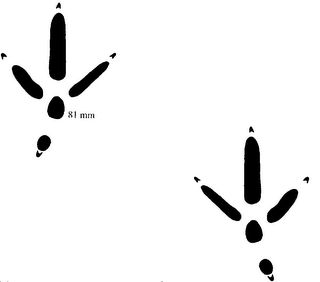
Status
Very common resident.
Order: Galliformes. Family: Numididae
Description
53-58 cm, 1.4 kg. Round bodies which are black and heavily spotted with white; their heads are small, with red facial skin and a red or yellow bony casque contrasting with the blue skin of the upper neck and cheeks. Wings are short and rounded and the tail is also short. Legs and feet are black; eyes brown and the bill yellow.
Chicks: buffy-brown, striped darker. Juvenile predominantly brown, darker on upperparts, head-stripes remaining until casque has started growing.
Immature resembles adult but has feathered neck and troat, dark brown helmet and rudimentary casque.
Distribution
Widespread in Africa south of the Sahara, but generally absent from rain forest and desert. Within southern Africa, its distribution has expanded with the spread of agriculture. Evidently, before 1900 it did not occur in what is now known as the Western Cape.

Habitat
This is a common and familiar bird of bushveld, farmlands and open grassland areas across the country. Also in other dry, open habitats with scattered shrubs and trees such as savanna.
Diet
Omnivorous: Invertebrates (predominate in breeding season), insects: e.g. grasshoppers, termites; plant matter (predominates in non-breeding season): bulbs, plant stems, seeds.
Breeding
Helmeted Guineafowl are monogamous. The nest is made by the female and consists of a scrape in the ground lined with grass stems and feathers and hidden among grass or other vegetation. Breeding generally follows good rains. Laying dates: Namibia, Botswana and Zimbabwe: January - March. South Africa - summer rainfall region: peak from October to March. South Africa - winter rainfall region: peak from September to December. There can be as many as 41 eggs in a single nest but this is due to egg dumping by other females. Thought that clutches of up to 12 eggs can be attributed to a single female. One egg is laid per day and the female then incubates the clutch for 24-27 days before they hatch. Chicks are precocial and can feed for themselves within 24 hours. They can fly short distances by 14 days old. Downy appearance is lost after 3 weeks and by 5 weeks they have juvenile plumage. In the first two weeks of life for the chicks, the male cares for them most of all (up to 80% of his time) - helping to locate insects for them and brooding them at night.
Call
Helmeted Guineafowl can be quite noisy, with a loud staccato call kek-kek-kek-kek or ker-tek-ker-tek-ker-tek-chrrrrand often with many birds calling at the same time. I gives also a 2-note buck-wheat, buck-wheat contact call. Listen to Bird Call.
Spoor

Status
Very common resident.
Helmeted Guineafowl Photos
203. Helmeted Guineafowl Numida meleagris
 © Toko
© Toko
Garden Route National Park, Wilderness
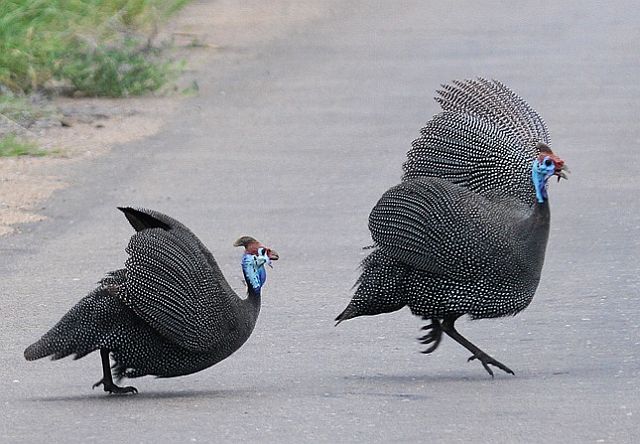 © leachy
© leachy
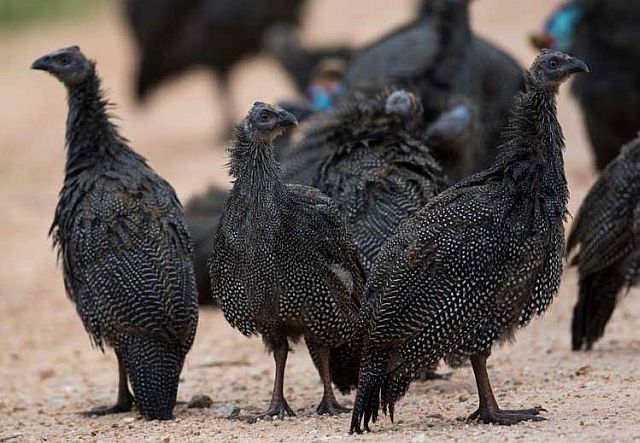 © Pumbaa & Timon
© Pumbaa & Timon
 © pooky
© pooky
Kruger National Park, S126
Links:
Species text Sabap1
Sabap2
Sanbi
 © Toko
© TokoGarden Route National Park, Wilderness
 © leachy
© leachy © Pumbaa & Timon
© Pumbaa & Timon © pooky
© pookyKruger National Park, S126
Links:
Species text Sabap1
Sabap2
Sanbi
Crested Guineafowl
204. Crested Guineafowl Guttera edouardi (Kuifkoptarentaal)
Order: Galliformes. Family: Numididae
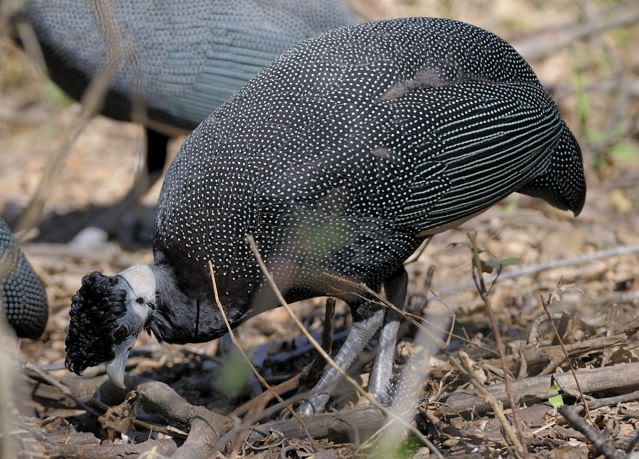
Description:
46-53 cm. Irridescent black with fine white spots. The outer secondaries have creamy-white outer webs, showing as a pale edge on the folded wing. Face bare with blueish grey skin. Crest black with fine curled feathering. Eye red.
Distribution
Found in West Africa, East Africa, Central Africa and Southern Africa. Within southern Africa, found in northern Limpopo, northern KwaZulu-Natal, eastern Swaziland, Mozambique, Zimbabwe, Caprivi in Namibia.
Habitat
Coastal and dune forests, riparian and montane forests, thickets and dense woodland. Generally seen on road verges in dense woodland and forest, or at bush camps, where they become habituated to humans.
Diet
It forages on the ground for seeds, fruit, stems, leaves, bulbs, roots and invertebrates.
Breeding
Monogamous. The nest is a shallow scrape in the ground in dense cover. Two to twelve eggs (usually 4-7) are laid October to February after first heavy rains. The female incubates them for about 23 days before they hatch. The parents guard the chicks throughout their development.
Call
Noisy and loud clucking call chuk-chuk-chukchuker-chuk-chuk. Listen to Bird Call.
Status
Locally common resident.
Order: Galliformes. Family: Numididae

Description:
46-53 cm. Irridescent black with fine white spots. The outer secondaries have creamy-white outer webs, showing as a pale edge on the folded wing. Face bare with blueish grey skin. Crest black with fine curled feathering. Eye red.
Distribution
Found in West Africa, East Africa, Central Africa and Southern Africa. Within southern Africa, found in northern Limpopo, northern KwaZulu-Natal, eastern Swaziland, Mozambique, Zimbabwe, Caprivi in Namibia.
Habitat
Coastal and dune forests, riparian and montane forests, thickets and dense woodland. Generally seen on road verges in dense woodland and forest, or at bush camps, where they become habituated to humans.
Diet
It forages on the ground for seeds, fruit, stems, leaves, bulbs, roots and invertebrates.
Breeding
Monogamous. The nest is a shallow scrape in the ground in dense cover. Two to twelve eggs (usually 4-7) are laid October to February after first heavy rains. The female incubates them for about 23 days before they hatch. The parents guard the chicks throughout their development.
Call
Noisy and loud clucking call chuk-chuk-chukchuker-chuk-chuk. Listen to Bird Call.
Status
Locally common resident.
Crested Guineafowl Photos
204. Crested Guineafowl Guttera edouardi (Kuifkoptarentaal)

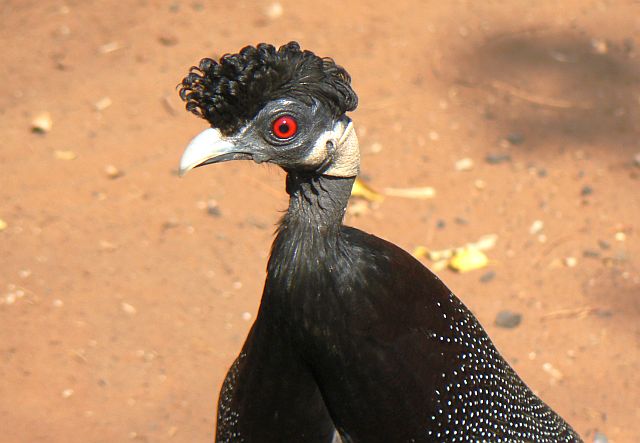 © Toko
© Toko
Mkhuze Game Reserve, KwaZulu-Natal
Links:
Species text Sabap1
Sabap2

 © Toko
© TokoMkhuze Game Reserve, KwaZulu-Natal
Links:
Species text Sabap1
Sabap2
Family Phasianidae (Spurfowl, Francolin, Old World Quails, Partidge, Peafowl)
Family Phasianidae (Spurfowl, Francolin, Old World Quails, Patridge, Peafowl)
Phasianidae is a diverse group comprising over 50 genera and over 214 species. Phasianid galliforms are commonly known as grouse, turkeys, pheasants, partridges, francolins, and Old World quail. Phasianids are small to large, blunt-winged terrestrial birds. Some species are noted for elaborate courtship displays in which males strut about, displaying colorful plumage and wattles, sometimes accompanied by an expansive spreading of the tail feathers. Some members of this group are important game birds and others, like domestic chickens (derived from Gallus gallus), are bred and reared for human consumption.
Phasianids are small to large, ranging from 500 g to 9.5 kg in weight. Phasianids have short, rounded wings. Tail length is variable by species, appearing almost tailless in some to up to one meter in others. Plumage coloration ranges from cryptic to dark to brightly -patterned. The legs are sturdy and one or more spurs may be present on the tarsus. Toes are short with blunt claws and the hallux is raised. Phasianids may have crests, or bare skin on the head or neck, or wattles. Physical characteristics may be sexually monomorphic or dimorphic depending on species. Some phasianid males are larger, more brightly colored, have longer tails or more elaborate ornamentation than females.
Phasianidae is a diverse group comprising over 50 genera and over 214 species. Phasianid galliforms are commonly known as grouse, turkeys, pheasants, partridges, francolins, and Old World quail. Phasianids are small to large, blunt-winged terrestrial birds. Some species are noted for elaborate courtship displays in which males strut about, displaying colorful plumage and wattles, sometimes accompanied by an expansive spreading of the tail feathers. Some members of this group are important game birds and others, like domestic chickens (derived from Gallus gallus), are bred and reared for human consumption.
Phasianids are small to large, ranging from 500 g to 9.5 kg in weight. Phasianids have short, rounded wings. Tail length is variable by species, appearing almost tailless in some to up to one meter in others. Plumage coloration ranges from cryptic to dark to brightly -patterned. The legs are sturdy and one or more spurs may be present on the tarsus. Toes are short with blunt claws and the hallux is raised. Phasianids may have crests, or bare skin on the head or neck, or wattles. Physical characteristics may be sexually monomorphic or dimorphic depending on species. Some phasianid males are larger, more brightly colored, have longer tails or more elaborate ornamentation than females.
Family Phasianidae Index
Species native or naturalised in southern Africa:
Family Phasianidae
Alectoris chukar Chukar Partridge (introduced) 187
Peliperdix coqui Coqui Francolin 188
Scleroptila afra Grey-winged Francolin 190
Scleroptila levaillantii Red-winged Francolin 192
Scleroptila shelleyi Shelley's Francolin 191
Scleroptila gutturalis Orange River Francolin 193
Dendroperdix sephaena Crested Francolin 189
Pternistis hartlaubi Hartlaub's Spurfowl 197
Pternistis adspersus Red-billed Spurfowl 194
Pternistis capensis Cape Spurfowl 195
Pternistis natalensis Natal Spurfowl 196
Pternistis afer Red-necked Spurfowl 198
Pternistis swainsonii Swainson's Spurfowl 199
Coturnix coturnix Common Quail 200
Coturnix delegorguei Harlequin Quail 201
Coturnix adansonii Blue Quail 202
Pavo cristatus Indian Peafowl (introduced) 924
https://www.worldbirdnames.org/bow/pheasants/
Family Phasianidae
Alectoris chukar Chukar Partridge (introduced) 187
Peliperdix coqui Coqui Francolin 188
Scleroptila afra Grey-winged Francolin 190
Scleroptila levaillantii Red-winged Francolin 192
Scleroptila shelleyi Shelley's Francolin 191
Scleroptila gutturalis Orange River Francolin 193
Dendroperdix sephaena Crested Francolin 189
Pternistis hartlaubi Hartlaub's Spurfowl 197
Pternistis adspersus Red-billed Spurfowl 194
Pternistis capensis Cape Spurfowl 195
Pternistis natalensis Natal Spurfowl 196
Pternistis afer Red-necked Spurfowl 198
Pternistis swainsonii Swainson's Spurfowl 199
Coturnix coturnix Common Quail 200
Coturnix delegorguei Harlequin Quail 201
Coturnix adansonii Blue Quail 202
Pavo cristatus Indian Peafowl (introduced) 924
https://www.worldbirdnames.org/bow/pheasants/


